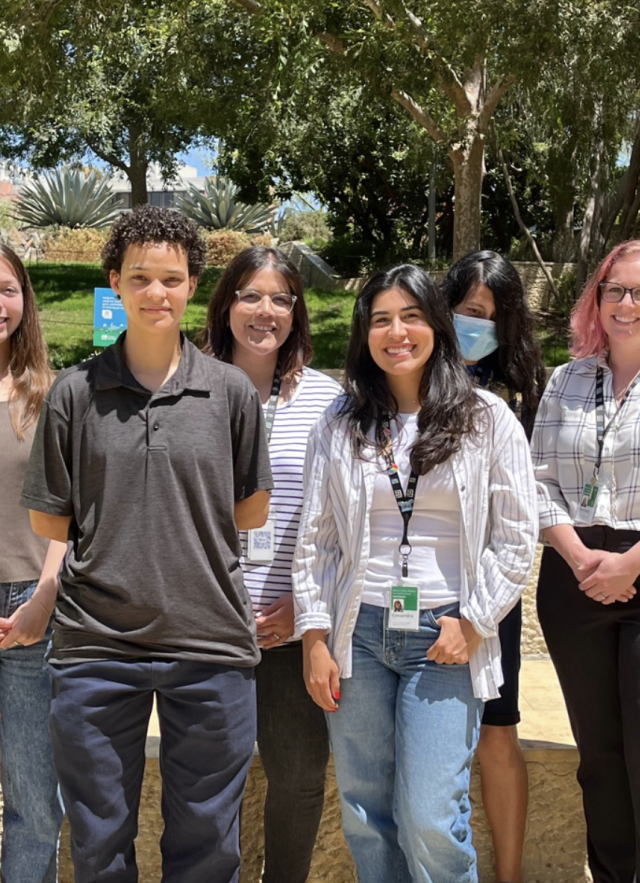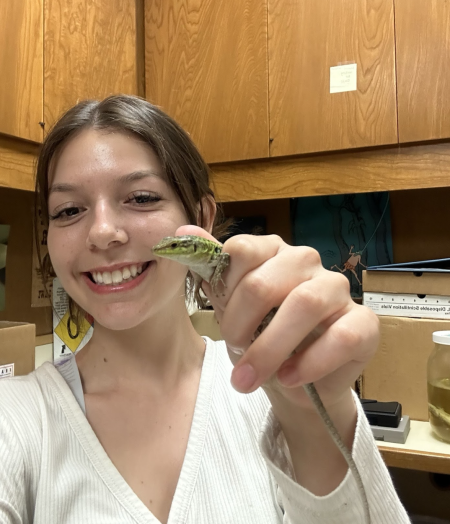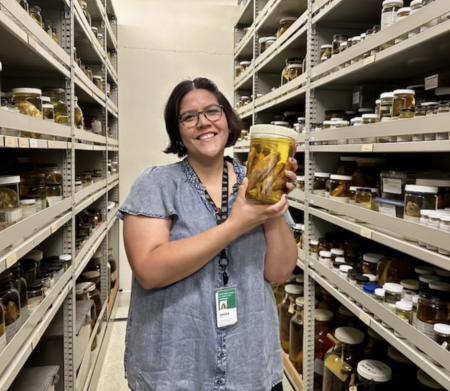Baccalaureates in Biodiversity
Meet the first graduating class of NHMLAC’s extraordinary mentorship and apprenticeship program—UNLAB (Understanding Nature and L.A. Biodiversity). Discover what eight college grads learned about fish, snails, and other creatures of the natural world from ancient times to the present—and how to protect them in the future.

Published August 7, 2024
Talented and tenacious, the eight mentees of UNLAB—which stands for Understanding Nature and Los Angeles Biodiversity through Museum Collections and Field Research—have finished up their year-long apprenticeship at NHM and La Brea Tar Pits. They left evidence of their data-collection industriousness in the museums’ databases, examined tiny samples with the scanning electron microscope, tucked the specimens back into their cabinets, and marched their fieldwork boots to their next scientific adventure. Alongside their mentors, museum science curators schooled in biology and paleontology, this year’s inquisitive crew trained their brains on the interconnection between biodiversity and humans.
The knowledge they collected over their year-long journey—on ancient avian fossils, native grasslands, microplastics in fish, marine protected areas, atmospheric pollution in bird feathers, ground squirrel survival strategies, the presence of rodenticides in snakes, the distribution of a local snail—will help museum scientists, and researchers from around the world, understand SoCal’s astounding biodiversity, and the daily threats that our flora and fauna face. Funded by a three-year National Science Foundation grant, UNLAB is designed to develop applied research skills and expose post-baccalaureates to collections-based research. One overarching goal of the endeavor is to be a catalyst for the development of a more representative STEM and museum workforce.
Dre’Shawn Frencher, Program Manager of the UNLAB Mentoring Program, who has focused his career on working with diverse and historically marginalized communities, says UNLAB is important because it provides valuable opportunities.
“There are all kinds of reasons that someone might not have had access to the research experience they need to continue in these fields. For example, I have worked with people who grew up in poverty or [are from] backgrounds who, instead of being able to take labs after school or do unpaid opportunities, had to work while they were attending school,” Frencher said. “I'm grateful that we were able to give folks a space to truly, hopefully level the playing field.”
Allison Shultz, Associate Curator of Ornithology, and a cohort leader, says a testament of NHMLAC’s commitment to UNLAB is evident in the fact that the museum’s leaders are intentionally dedicating research staff to the effort, and making mentorship a priority.
Poisoned Snakes and Public Speaking

Taylor Vasquez who has a Bachelors of Science in Wildlife, Fish, and Conservation Biology from the University of California, Davis, relished her year in the museum world. She joined her mentor, Herpetology Curator Greg Pauly, to examine if snakes in the wild can be tested for ingesting rodenticide (rat poison) accumulated from the prey they eat. She dissected the [snake’s] liver, took a sample, then, "then shipped them to U.C. Davis's Food and Safety Laboratory to be tested.”
“Poisons [as rodent pest control] are probably the worst thing that you could do. Once the pest consumes rodenticides, a predator will consume that pest and they will be exposed,” she said. Beyond the research itself, Vasquez said she learned an important skill—overcoming a fear of public speaking. The yearlong mentorship culminated in a symposium where she and her fellow mentees presented their findings to their peers, mentors, and families.
“When they said we were going to do a talk in front of people, I was really afraid because I've never done public speaking. So I was really nervous and scared about that. But when it came down to it, it was actually really nice and fun and I enjoyed it. That was a pleasant surprise to overcome that feeling.”
Dive into Science and the Water is Fine

Jessica Flores spent her year steeped in the world of fishes with Bill Ludt, NHM’s Associate Curator of Ichthyology. She combed through the collection to study the presence of human plastic pollution on native marine fish in Southern California over the past 80 years. Specifically, they looked at microplastics in filter-feeding and predatory northern lampfish.
Using the collection, chemical analysis, and the Raman Spectrometer, Flores and Ludt found that microplastics were consistently present in these mid-water fish since 1980. The relatively small sample size seems to indicate that plastic contaminants have been ubiquitous in marine environments for decades. Flores loved her time at the museum so much that she decided to try to stay on. “I feel very grateful. I feel very lucky to be able to stick around…when I first started working here, it was in a way, a secret goal of mine to see if I could find a way to stay,” Flores said.
“This is the first time that I was able to really see myself as a scientist. I got a degree in Marine Bio but [my experiences were in] animal care, husbandry, that type of stuff. So it feels a lot different to be reading the [research] papers, reviewing, and having discussions about the papers. I feel like going through this experience has helped me see, ‘Oh, I could definitely do this and I enjoy it.’ “
Projecting Organisms, Providing Opportunities
Brenda Barrera Escamilla spent her year researching the human impact on local rocky intertidal communities by measuring invertebrate community composition and biodiversity within and outside of Marine Protected Areas (MPAs) along the Rancho Palos Verdes Peninsula. What she found was some behaviors of humans—trampling, handling of organisms, overturning of rocks— aren’t being well regulated even under these protections. Beyond that finding, the best part of Escamilla’s year was working with her mentors, Austin Hendy, Assistant Curator, Invertebrate Paleontology, and Kelvin Barwick.
“They would always make themselves available to answer any questions I had related to my research project and would provide a different perspective on how to approach certain aspects,” she said. “I just want to say thank you to everyone who gave me the opportunity to be a part of UNLAB.”
Where They’ll Go
Jann Vendetti, NHM’s Associate Curator of Malacology, is heartened by the achievements of this first UNLAB crop and is excited for the new mentees—Cohort 2—who began their apprenticeship earlier this summer.
“The program is about enabling college graduates to feel confident enough to consider doing scientific research, Vendetti says. They were taught essential skills and techniques, but also learned about networking and professional development. Vendetti says that the future paths of UNLAB alumni don’t necessarily have to be in a museum or academic field for the initiative to be considered successful. “This program is supposed to be a ramp. A ramp from where you are to where you want to go.”